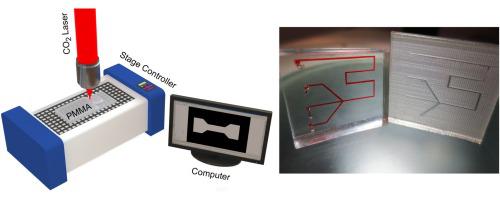Journal of Industrial and Engineering Chemistry ( IF 6.1 ) Pub Date : 2021-03-26 , DOI: 10.1016/j.jiec.2021.03.033 Mustafa Tahsin Guler , Murat Inal , Ismail Bilican

|
In this study, a new method for the fabrication of polydimethylsiloxane (PDMS) microchannels through the replication of plexiglass molds was developed. A plexiglass slab is machined with CO2 laser in the raster mode to produce the mold for the PDMS casting. Then, the PDMS replica of the mold is plasma bonded to a substrate by applying more pressure than standard to overcome the surface roughness inherited from the laser machining process. Depending on the channel complexity, a ready to cast mold in the size of a glass slide can be achieved in 5–20 min, including the design, machining, and cleaning steps. This fully automated and cost-effective mold making method proved to be the fastest among all methods, and it enables up to 2.5 aspect ratio microchannels, down to a width of 60 μm, and a height of 23 μm. The raster mode of the laser provides features lower, in size, then the laser beam waist radius. The produced microchannels were validated using several applications, such as droplet generation, nanofiber production, and viscoelastic microparticle focusing.
中文翻译:

用于PMMA微流体模具制造的CO 2激光加工,应用于粘弹性聚焦,静电纺纳米纤维生产和液滴产生
在这项研究中,开发了一种通过有机玻璃模具复制制造聚二甲基硅氧烷(PDMS)微通道的新方法。用光栅模式的CO 2激光加工有机玻璃平板,以生产用于PDMS铸造的模具。然后,通过施加比标准压力更大的压力,将模具的PDMS复制品等离子粘合到基材上,以克服激光加工过程中遗留的表面粗糙度。根据通道的复杂程度,可以在5至20 分钟内完成玻璃载玻片大小的现成模具的铸造,包括设计,加工和清洁步骤。事实证明,这种全自动且具有成本效益的模具制造方法是所有方法中最快的,并且它可以启用多达2.5个长宽比的微通道,最小宽度为60 μm,高度为23μm 。激光的光栅模式提供的特征尺寸比激光束腰部半径小。使用多种应用程序验证了产生的微通道,例如液滴的产生,纳米纤维的产生以及粘弹性微粒聚焦。


























 京公网安备 11010802027423号
京公网安备 11010802027423号